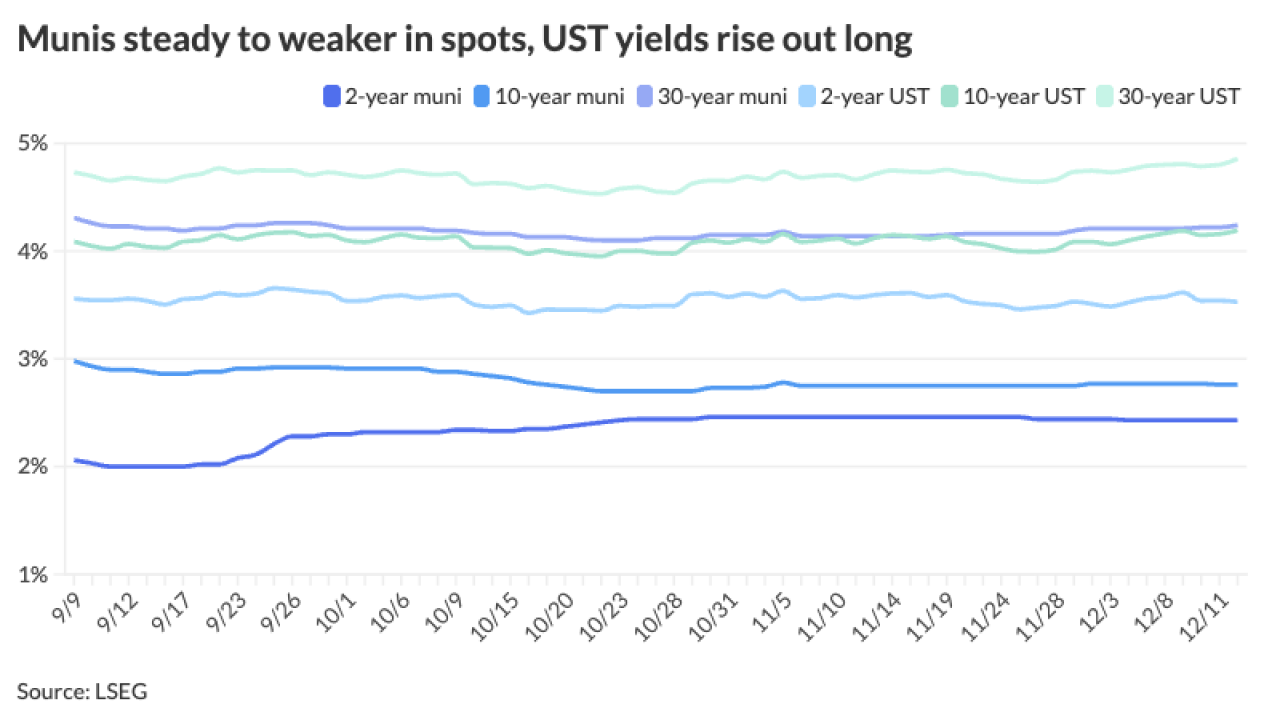Task forces on Libor are being formed by two public finance professional organizations as anticipation grows over the technical challenges involving its phaseout.
The Government Finance Officers Association and National Association of Bond Lawyers both are in the process of forming committees to examine the unresolved issues facing the municipal bond market.
Members of GFOA’s Debt Committee agreed Monday to form a working committee that will publicize the issues involved in the transition among the organization’s more than 21,000 members.
Libor, an acronym for the London Interbank Offered Rate, is being phased out at the end of 2021 based on a recommendation of the Alternative Reference Rates Committee that was created by the U.S. Federal Reserve Board and the Federal Reserve Bank of New York.
The U.S. Treasury and Internal Revenue Service have not yet finalized proposed rules that were released in October to help taxpayers avoid adverse tax consequences from changing the terms of debt, derivatives, and other financial contracts to alternative reference rates from interbank offered rates such as Libor.
The new alternative reference rates cited by Treasury and the IRS include the Secured Overnight Financing Rate (SOFR), published by the New York Fed, and the federal funds rate.

Treasury is including all other interbank offered rates, or IBORs in other countries, including Switzerland, Japan and the European Union.
Likewise, the public finance sector is awaiting finalized regulations from the Governmental Accounting Standards Board on removal of all interbank offered rates as an appropriate benchmark interest rate effective for reporting periods beginning after Dec. 15, 2020.
GASB’s final rules are expected to be announced in March, but the release date for the final Treasury-IRS rules is uncertain.
In addition, governmental issuers still do not have templates or protocols for documents that would comply with the new reference rates. Those protocols are expected to be issued by the International Swaps and Derivatives Association.
“We want to light a fire under ISDA,” said Emily Brock, director of GFOA’s Federal Liaison Center. “I think the concern among the debt committee is that the conversion to SOFR or away from Libor on legacy contracts has not yet been effectively established in the form of ISDA protocols. We are still waiting for the ISDA protocols to come out.”
Brock said some GFOA members are still signing Libor-based contracts.
“We want to ensure that issuers are being very deliberate as they engage in Libor contracts that those Libor contracts have sufficient fallbacks or that they are able to make a conversion,” she said.

NABL’s committee on Libor is being headed by E. Tyler Smith, a tax partner at Parker Poe in Greenville, South Carolina and former NABL board member.
“We are just cranking up and populating the committee,” Smith said Tuesday, indicating there will be six to eight members representing the securities, tax and Libor perspectives.
Smith expects there will be significant interaction between his committee and those formed by GFOA and other groups such as ISDA and the Loan Syndications and Trading Association.
Smith said there are variable-rate bonds with interest rates tied to Libor and a very large market of direct purchase bonds where banks or another financial institution will hold a bond privately with the interest rate based on Libor.
Debby Cherney, CEO of the San Bernardino County Employees Retirement Association and a member of the new GFOA committee on Libor, said her foremost concern is that some small issuers “are probably not aware Libor is going away.’’
“That’s going to affect them even if they are a small government that’s buying fleet vehicles based on a Libor interest rate,” Cherney said. “It may not be as big as some of our swap transactions. I think this is so embedded in our borrowing system that it’s going to affect people in ways that they don’t even know."
David Erdman, capital finance director for the state of Wisconsin, said he wants to “make sure there is a fair conversion from Libor to SOFR.”
“There’s that spread that’s being talked about and we want to make sure it’s a fair and equitable spread and it doesn’t bounce around,” Erdman said. “I’ve heard from the GASB guidance that with the conversion from Libor to SOFR, we may lose our perfect hedge, which for us is important because we have swaps that are perfect swaps.”
GASB’s final guidance on the Replacement of Interbank Offered Rates is expected to be issued in March, giving state and municipal governments plenty of time to make adjustments before Libor is phased out by the end of 2021.
The guidance will help issuers avoid adverse tax consequences from changing the terms of debt, derivatives, and other financial contracts to alternative reference rates.
S&P Global estimates there are 1,400 different municipal bond market issuers with variable-rate debt.
The GASB guidance proposes removal of all interbank offered rates as an appropriate benchmark interest rate effective for reporting periods beginning after Dec. 15, 2020.
The proposal was broadened beyond Libor to include all other IBORs offered in other countries, including Switzerland, Japan and the European Union.
The proposed GASB statement allows governments to continue using hedge accounting for certain hedging derivative instruments that are amended or replaced to change the reference rate from an IBOR.
It also clarifies the hedge accounting termination provisions when an IBOR is replaced as the reference rate of a hedged item and that the uncertainty associated with reference rate reform does not, by itself, affect the probability that an expected transaction will occur.





